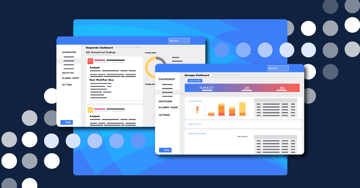IT teams are adding extended detection and response (XDR) to their security stack for a more integrated approach to threat detection, response, and mitigation. XDR uses data from multiple sources across an organization’s entire ecosystem to paint a comprehensive picture of potential threats.
Blumira has assessed the five approaches to XDR platforms in a side-by-side comparison to help you weigh the pros and cons of each type of solution. Read our full report for more detail and a list of questions that will help you identify the needs of your organization.
Cloud-Native XDR solutions leverage cloud architecture for flexible and scalable analysis, especially for organizations with high or variable data volumes. Built-in AI and behavioral analytics enables advanced detection without extensive tuning. Vendor-specific cloud-native XDR does well within its platform environment, but provides less support for third-party platforms; visibility is limited to cloud-based sources. Costs can be unpredictable as data volumes grow and demand additional cloud resources.
Closed XDR solutions target enterprise-scale organizations with a hybrid solution. These vendor-specific systems are tied to the provider’s platform and are often complex to set up, tune, and maintain. Many closed XDR solutions require add-ons for automated response, long-term data retention, and 24/7 support.
EDR-Based XDR solutions use endpoint data for AI-driven threat hunting based on behavioral patterns and the MITRE ATT&CK framework. Extensive tuning and optimization is often required to prevent “alert fatigue” from noisy detections which can distract users from identifying high-impact threats.
AI-Driven XDR solutions use AI and machine-learning algorithms to detect threats and automate responses. They’re currently limited to specific data sources, struggling with correlation across many different sources. Higher false positives tend to show up until the system is trained on a sufficient amount of data.
SIEM-Driven XDR solutions start with a robust security information and event management solution (SIEM) as a base and integrates XDR capabilities. The Blumira approach combines compliance, log analysis, security analytics, and automated response in a single platform. The result is better correlation across diverse sources—firewalls, cloud integrations, and endpoints. The Blumira approach gives equal importance to compliance and security, providing value to multiple stakeholders. The flexible pricing model provides the ability to collect and retain mass amounts of data without corresponding cost increases.
Choosing Blumira
While it seems that everything about security and compliance is getting more complex, Blumira has built a solution that does more while making life easier for IT teams. Blumira stands out for providing comprehensive visibility with less distracting noise, earlier detection and automated response to stop attackers in their tracks, guided response playbooks and 24/7 SecOps support, and a data-first approach with time-saving compliance capabilities.
Blumira’s SIEM + XDR platform makes advanced detection and response easy and effective for small and medium-sized businesses, accelerating ransomware and breach prevention for hybrid environments. Time-strapped IT teams can do more with one solution that combines SIEM, endpoint visibility and automated response. Contact us today to find out more or schedule a demo.
More from the blog
View All Posts
Choosing the Right XDR Solution: Comparing 5 Approaches
Read More
SIEM vs XDR vs SOAR vs SOC vs EDR vs MDR
Read More
Top 10 XDR Definitions | Blumira: Extended Detect & Response
Read MoreSubscribe to email updates
Stay up-to-date on what's happening at this blog and get additional content about the benefits of subscribing.